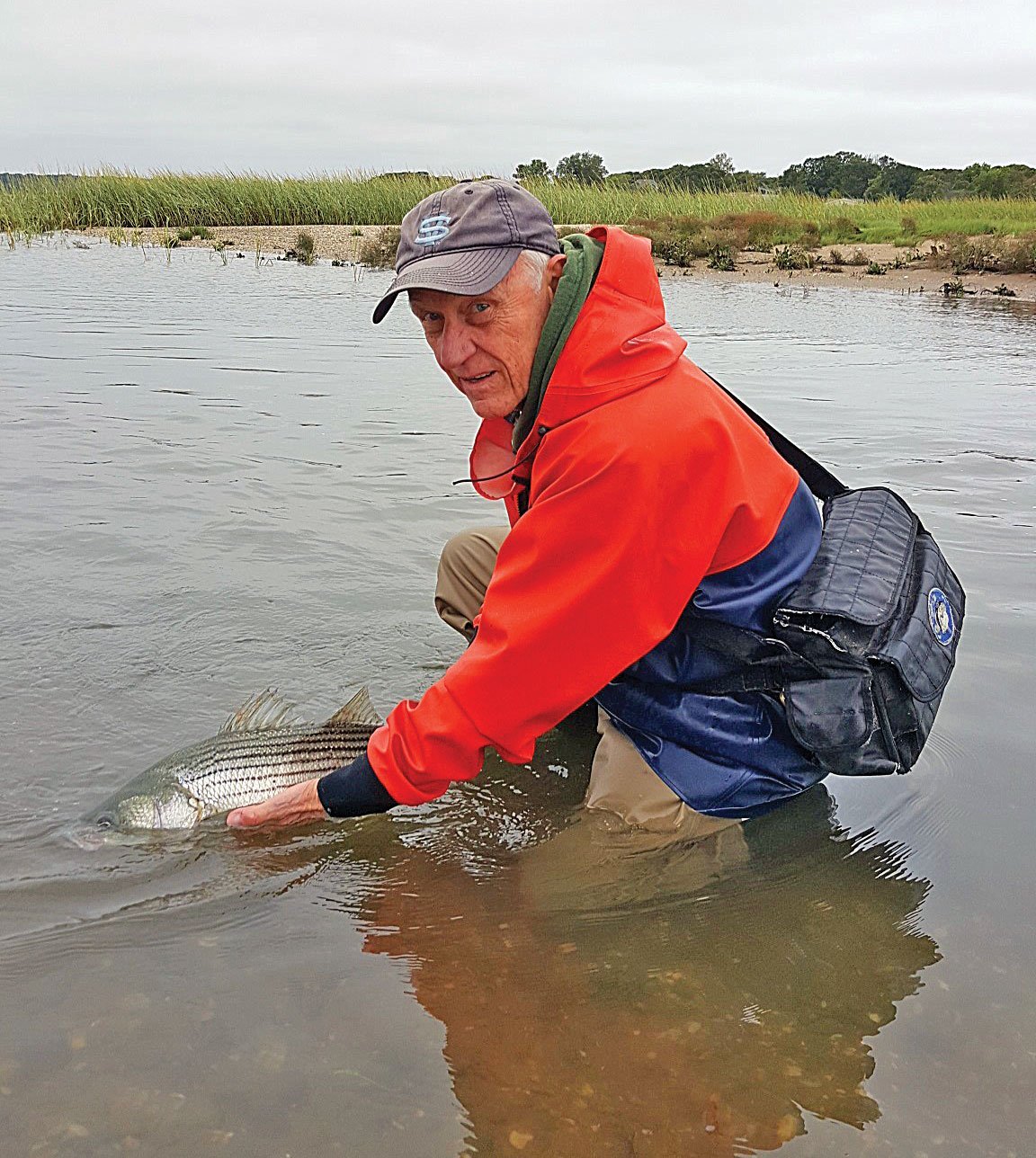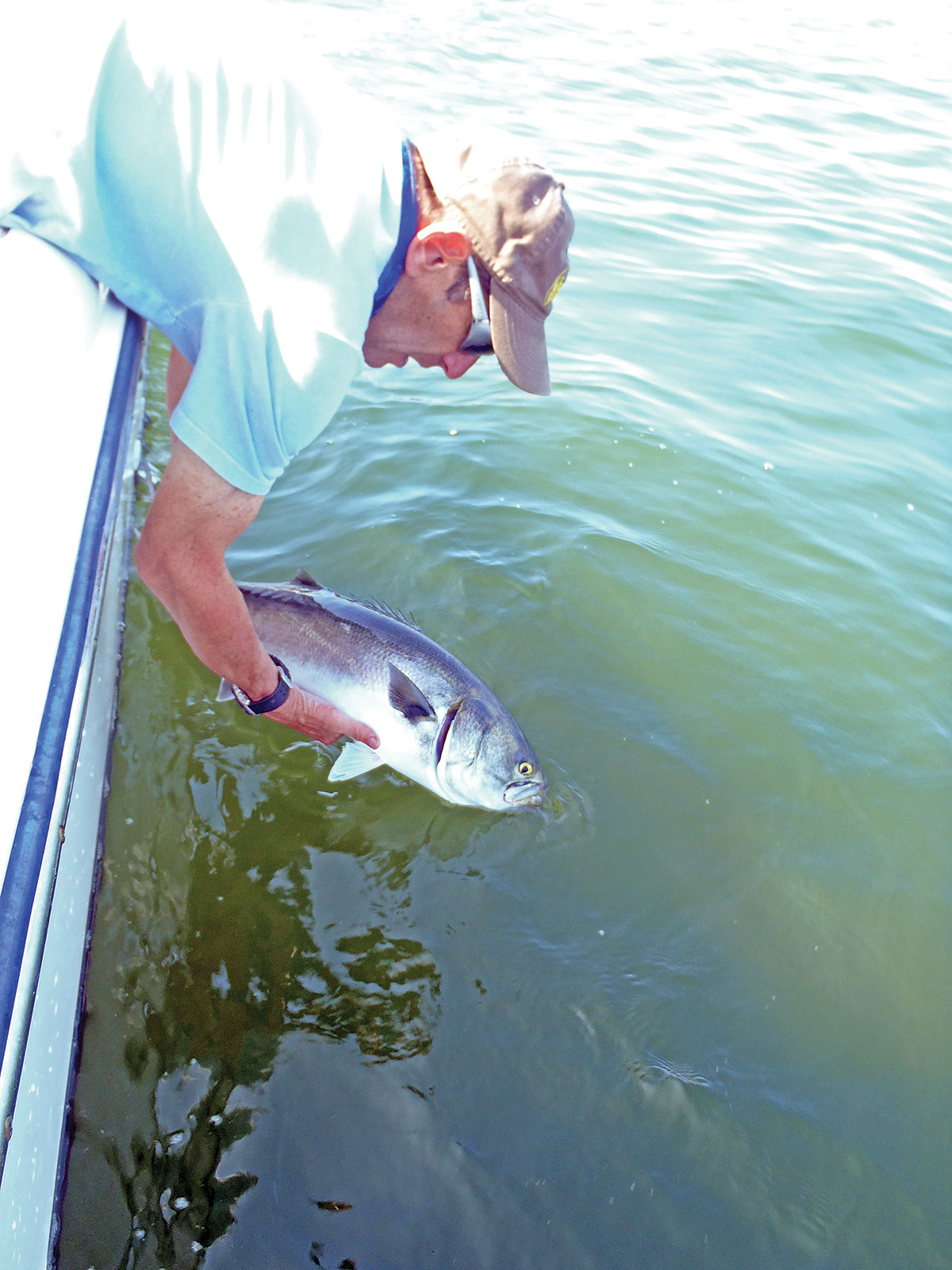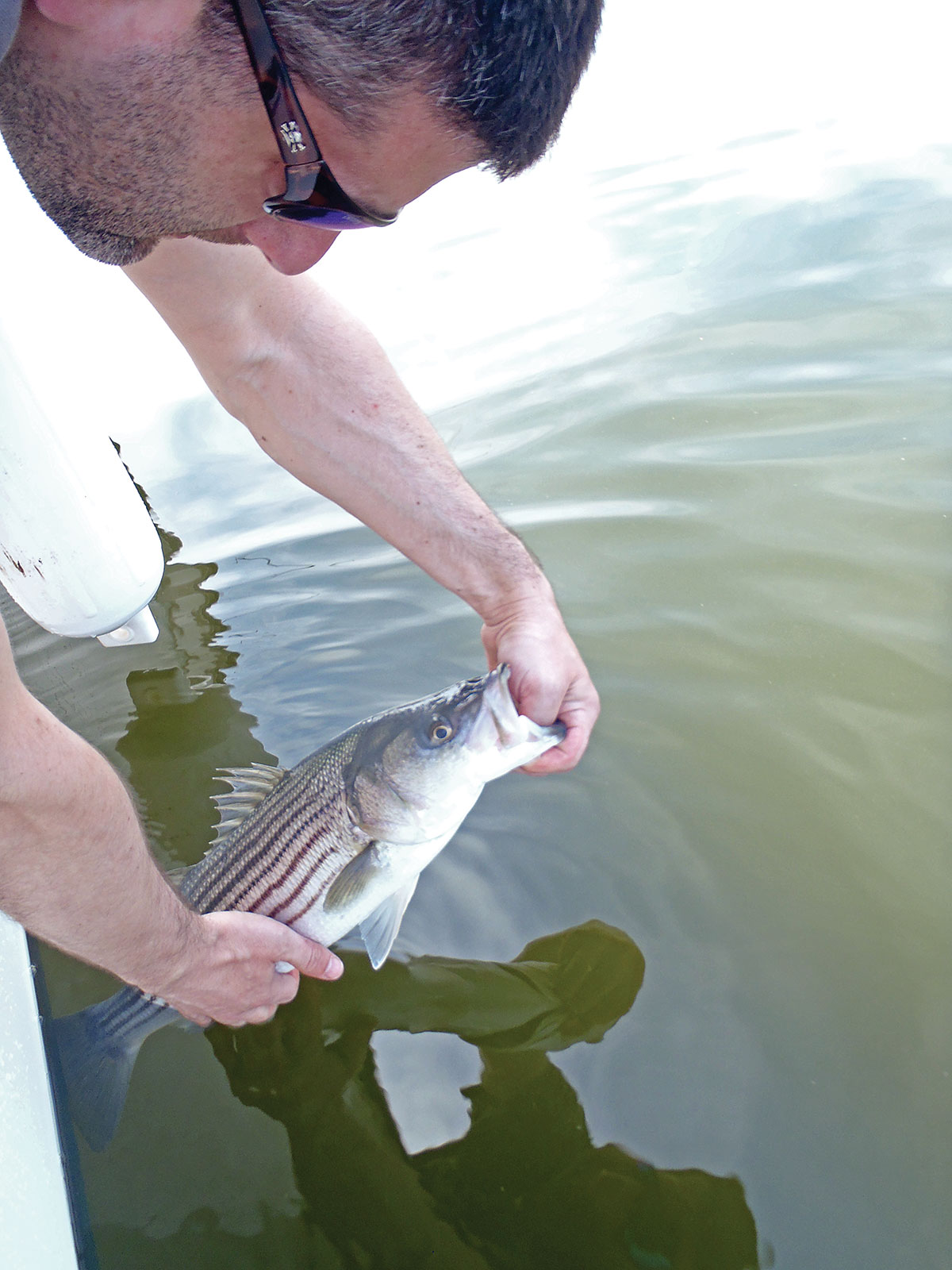Here are five things we can do to take a huge bite out of catch and release mortality.
Recently, catch and release information has come at anglers from many directions, and when you read some of the documents and articles, the suggestions are numerous and descriptively long. Even as a scientist its information overload for me. So, I began thinking, can we take a serious bite out of catch and release mortality and still keep it simple and logical? I believe we can.

Fish Need Our Help
I intend to offer ideas for both surf and boat anglers, but let’s begin with striped bass since catch and release mortality for the species has been a hot button for some time. The data from the Scientific and Technical Committee of the Atlantic States Marine Fisheries Commission indicates that striped bass catch and release mortality is 9%. This seems like a low percentage and it is. It’s also better that the 15% they were touting ten years ago. But there is a problem. It’s that 9 percent is a lot of fish, fish that if they survived would expand catch opportunities for anglers as well as allow more fish to mature and spawn, adding to the adult spawning biomass. Now, that couldn’t be a bad thing!
What Do You Believe?
Do you believe that most of your released fish survive? Do you believe that if the fish swims away it will survive? Well, research shows a significant number of weakfish, blues, and stripers that swim away will die within 3 days because they weren’t fought, landed, or handled properly. Ask yourself the above questions again after reading this article. If you discover bad habits, don’t be critical of yourself, but do reconsider what you do and how you do it. In truth, most poor angling practices, including releasing fish, were taught to us by someone who may or may not have an informed background.
Similar but Different
In truth, common sense catch-and-release techniques work for any species regardless of how or where they are caught. Yet, there are specifics that vary, too. Many small species are landed quickly such as porgy, and some are tough such as blackfish and can be unhooked and returned to the water without fanfare. There are also some very large species such as marlin and tuna that require special catch and release approaches. Most people who fish for these large gamefish either already know how to do it, or charter to catch them and the captains know what to do. However, for the typical angler who fishes inshore from a boat or from the beach, the main concern is how to release stripers, bluefish, and weakfish, and they can all be handled in a similar way.
Simple is Better
Most anglers want to do the right thing, respect their quarry, and understand that properly released fish today could mean more fish and more fun tomorrow. To that end, I promised I’d cut through the jargon and complicated ideas about catch and release, and I intend to do that right now! Here are the five things I believe an angler can do to reduce catch and release mortality. It isn’t everything we can do, but if we follow this simple ethic, we can take a huge bite out of catch and release mortality.
- Use species appropriate tackle.
- Return fish to the water as fast as possible.
- Handle the fish as little as possible.
- Use single hooks instead of trebles on lures, and circle hooks when baitfishing.
- “Walk” larger fish back to vitality before releasing.
Let’s take a closer look at these items, one by one.
Use Proper Tackle: The use of light tackle is fun and sporting, but some people take it too far. I have an acquaintance who uses his freshwater perch and crappie rod for striped bass fishing in the surf when it’s calm. Although I’ve tried to explain to him how that’s too much stress for a striper, he’s dug-in on a light tackle idea that just doesn’t work in that situation. So, there’s light tackle and light tackle. In calm waters in harbors and bays, I use a 7-foot rod (Teramar) with a VS 150 and 15-pound test braid both in a boat and from shore. The Teramar is a medium-heavy blank with a fast action tip. The fast action tip casts most lures a very long way, and the rod’s backbone can, with the right drag, tame even large fish quickly. However, I wouldn’t dream of using that rod in the ocean surf, chasing big fish in a boat, or live-lining, because it isn’t fair to the fish, and turns angling into an awkward unbalanced chore! Similarly, a 9-foot medium blank with a VS 200 (or equivalent reel) or an 11-foot medium blank with a VS 250 (or equivalent reel), both with 20-pound test braid is appropriate for the ocean surf, inlets, and in windy situations.

A sturdy leader is another piece of equipment that allows can angler to manage fish efficiently and return them to the water. In most situations, I use a 30-pound test leader with a 50-pound swivel on one end connected to the running line, and a Tactical Anglers 125-pound paperclip style snap on the other. This leader allows me to control a fish and remove the hook from smaller fish within seconds. I also always fish with gloves (either woven cotton or thin “mechanics” gloves). Always wet the gloves because dry gloves remove the fish’s slime – their protective layer. Gloves also provide the angler with a secure grip on leaders and fish, and allows an angler to lip a school fish without ending up with a sore scraped thumb.
Return Fish to the Water Quickly: Sadly, many anglers have not grasped a simple concept – humans breathe air and fish water. So, leaving fish flopping around out of water while admiring it, taking endless photos, or chatting with friends means the fish is suffocating. Sportsmen and good stewards of our marine resources do everything possible to return the fish to the water fast! Therefore, focus on the fish and not friends or admiration. Remove the hook and return the fish to the water. Talk and regale later.
Proper tools are needed to remove hooks quickly and effectively. I always have a 9-inch needle-nose pliers handy in a boat or on my surf belt. The proper way to remove a hook is the grab the bend of the hook; not the shaft, and pull it away from the point. Applying pressure to the hook shaft doesn’t provide enough leverage, may damage the fish, and often bends the hook. Of course, using single hooks rather than trebles makes hook removal easier, too.
If you want to take a picture of a fish, prepare for it in advance. For example, have the camera handy and ready to click. Or, have a friend set up for the photo while you are in the final stages of landing the fish. That way, the photographer can take several photos quickly and you can return the fish to the water fast.
Handle Fish as Little as Possible: When possible, land fish by grabbing the leader with wet hands or gloves. When possible, avoid sliding fish onto the sand. Never gaff a fish you intend to release. Avoid pressing the fish against your body (waders, top, shirt, etc.), because it removes lots of slime. Never, ever step on a fish when removing a hook. Pretend that you’re the fish and a person is stepping on you. Imagine this and you have a better grasp of how stepping on fish could damage internal organs. Never, ever throw a fish back into the water as if it were a football. Either drop a small fish carefully from a short distance (boat or beach), and in waves walk down to the water’s edge and underhand it a short distance into the water close to the water’s surface. Never, ever kick a fish back into the water. Similar to stepping on fish, think of how it would feel if you were the fish. Again, kicking can damage the gills, the eyes, and internal organs.
Hooks: Whenever possible, use lures with single hooks, or in-line circle hooks when fishing with bait. Circle hooks are better today than a decade ago and there are more choices for a greater variety of uses. Circle hooks are effective and safer for the fish because even when swallowed, the hook finds its way to the corner of the mouth. The only thing an angler needs to remember is, don’t set the hook. Rather take up the slack and let the fish set the hook. Circle hooks will become mandatory for bait fishing for striped bass in 2021.
I’ve tried to use single hooks on lures for a long time. It’s just one reason why I use bucktails so much, but “tins” and tins with tubes are also good single hook lures. Fortunately, anglers are an experimental lot, and in recent years enterprising anglers have come up with effective ways to remove trebles from plugs and replace them with single hooks. How to do this is available on-line (videos) and in articles. I did an article about using single hooks on poppers for the spring bluefish run just a few years ago. Changing plugs from trebles to single hooks has become quite popular in recent years. My point: the information is out there and readily available. As an added bonus, single hooks are safer for the angler and saves time with hook removal and getting the angler back into the action faster.

Reviving Fish: As indicated above, small fish don’t generally need lots of reviving. Since they are small, they don’t fight hard or long, and don’t build up enough waste products in their muscles, and it’s the waste products of muscle activity that cause the fish to go into shock. However, if an angler revives a fish, the process allows the fish’s organs to pull the wastes out of the muscles and void them. However, large fish, since they fight longer and harder, need more attention.
At the end of the process how does an angler know when the fish is ready for release? There are three main indicators. First, when a fish is ready, the dorsal fin will be erect. Second, when a fish is ready the fish will be able to maintain an upright orientation. Fish that are not ready will either roll on a side or belly up. Third, when a fish is ready it will begin to undulate, shake its head, and begin to try to pull free. When all three capabilities are restored, the fish may be released. To facilitate a successful release, I carry a gripper. There are many kinds including simple plastic models, a Boga Grip that’s also used to weigh fish, and devices that look like a Boga but lack a scale.
Surf Release: I’ve attached my gripper with an elastic cord to my belt. This way, I grab the fish’s lower jaw with the gripper and walk the fish without having to bend over: bending can be tiring, awkward, and dangerous in waves. Always move a fish forward, never back and forth because back and forth tends to drown them. Again, the gripper helps because I can walk back and forth until the 3 criteria are met.
From a Boat: Of course, a boat angler can only “walk” a fish a portion of the length of the boat to revive it. A boat angler can also use the gripper and move the fish forward along the gunwale, turn, and move in the opposite direction so that the fish is always moving forward, and of course the same 3 criteria for release apply.
The Effect of Temperature: Fish release easier in cooler water than in the warm water of summer. Large fish will take longer when water temperatures are 70 degrees F. or more. Bluefish and weakfish are more sensitive to warm water than stripers and are much more likely to die when improperly released. These two species are delicate in two different ways. I know we don’t think of blues as delicate, but they are when it comes to temperature because they are open water fish and their temperature tolerance range is narrow. At 70 degrees or above they stress out. Large weakfish winter in cold water on the continental shelf and therefore warm water is not on their “hit parade.” In warm water they fight hard, build up wastes, and are often difficult to revive. So, in the summer months please take special care and patience when releasing all large fish, but especially large blues and weakfish.
A proper release is easy and effective when an angler focuses on the 5 points above and applies a little effort and time to the process. After all, there’s something in it for all of us – more fish to catch!




